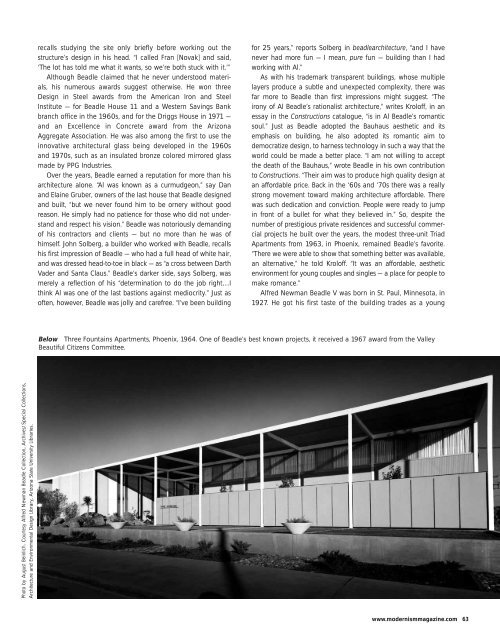Meet the BEADLES - Peter J. Wolf
Meet the BEADLES - Peter J. Wolf
Meet the BEADLES - Peter J. Wolf
Create successful ePaper yourself
Turn your PDF publications into a flip-book with our unique Google optimized e-Paper software.
Photo by August Beinlich. Courtesy Alfred Newman Beadle Collection, Archives/Special Collections,<br />
Architecture and Environmental Design Library, Arizona State University Libraries.<br />
recalls studying <strong>the</strong> site only briefly before working out <strong>the</strong><br />
structure’s design in his head. “I called Fran [Novak] and said,<br />
‘The lot has told me what it wants, so we’re both stuck with it.’”<br />
Although Beadle claimed that he never understood materials,<br />
his numerous awards suggest o<strong>the</strong>rwise. He won three<br />
Design in Steel awards from <strong>the</strong> American Iron and Steel<br />
Institute — for Beadle House 11 and a Western Savings Bank<br />
branch office in <strong>the</strong> 1960s, and for <strong>the</strong> Driggs House in 1971 —<br />
and an Excellence in Concrete award from <strong>the</strong> Arizona<br />
Aggregate Association. He was also among <strong>the</strong> first to use <strong>the</strong><br />
innovative architectural glass being developed in <strong>the</strong> 1960s<br />
and 1970s, such as an insulated bronze colored mirrored glass<br />
made by PPG Industries.<br />
Over <strong>the</strong> years, Beadle earned a reputation for more than his<br />
architecture alone. “Al was known as a curmudgeon,” say Dan<br />
and Elaine Gruber, owners of <strong>the</strong> last house that Beadle designed<br />
and built, “but we never found him to be ornery without good<br />
reason. He simply had no patience for those who did not understand<br />
and respect his vision.” Beadle was notoriously demanding<br />
of his contractors and clients — but no more than he was of<br />
himself. John Solberg, a builder who worked with Beadle, recalls<br />
his first impression of Beadle — who had a full head of white hair,<br />
and was dressed head-to-toe in black — as “a cross between Darth<br />
Vader and Santa Claus.” Beadle’s darker side, says Solberg, was<br />
merely a reflection of his “determination to do <strong>the</strong> job right…I<br />
think Al was one of <strong>the</strong> last bastions against mediocrity.” Just as<br />
often, however, Beadle was jolly and carefree. “I’ve been building<br />
for 25 years,” reports Solberg in beadlearchitecture, “and I have<br />
never had more fun — I mean, pure fun — building than I had<br />
working with Al.”<br />
As with his trademark transparent buildings, whose multiple<br />
layers produce a subtle and unexpected complexity, <strong>the</strong>re was<br />
far more to Beadle than first impressions might suggest. “The<br />
irony of Al Beadle’s rationalist architecture,” writes Kroloff, in an<br />
essay in <strong>the</strong> Constructions catalogue, “is in Al Beadle’s romantic<br />
soul.” Just as Beadle adopted <strong>the</strong> Bauhaus aes<strong>the</strong>tic and its<br />
emphasis on building, he also adopted its romantic aim to<br />
democratize design, to harness technology in such a way that <strong>the</strong><br />
world could be made a better place. “I am not willing to accept<br />
<strong>the</strong> death of <strong>the</strong> Bauhaus,” wrote Beadle in his own contribution<br />
to Constructions. “Their aim was to produce high quality design at<br />
an affordable price. Back in <strong>the</strong> ‘60s and ‘70s <strong>the</strong>re was a really<br />
strong movement toward making architecture affordable. There<br />
was such dedication and conviction. People were ready to jump<br />
in front of a bullet for what <strong>the</strong>y believed in.” So, despite <strong>the</strong><br />
number of prestigious private residences and successful commercial<br />
projects he built over <strong>the</strong> years, <strong>the</strong> modest three-unit Triad<br />
Apartments from 1963, in Phoenix, remained Beadle’s favorite.<br />
“There we were able to show that something better was available,<br />
an alternative,” he told Kroloff. “It was an affordable, aes<strong>the</strong>tic<br />
environment for young couples and singles — a place for people to<br />
make romance.”<br />
Alfred Newman Beadle V was born in St. Paul, Minnesota, in<br />
1927. He got his first taste of <strong>the</strong> building trades as a young<br />
Below Three Fountains Apartments, Phoenix, 1964. One of Beadle’s best known projects, it received a 1967 award from <strong>the</strong> Valley<br />
Beautiful Citizens Committee.<br />
www.modernismmagazine.com 63


